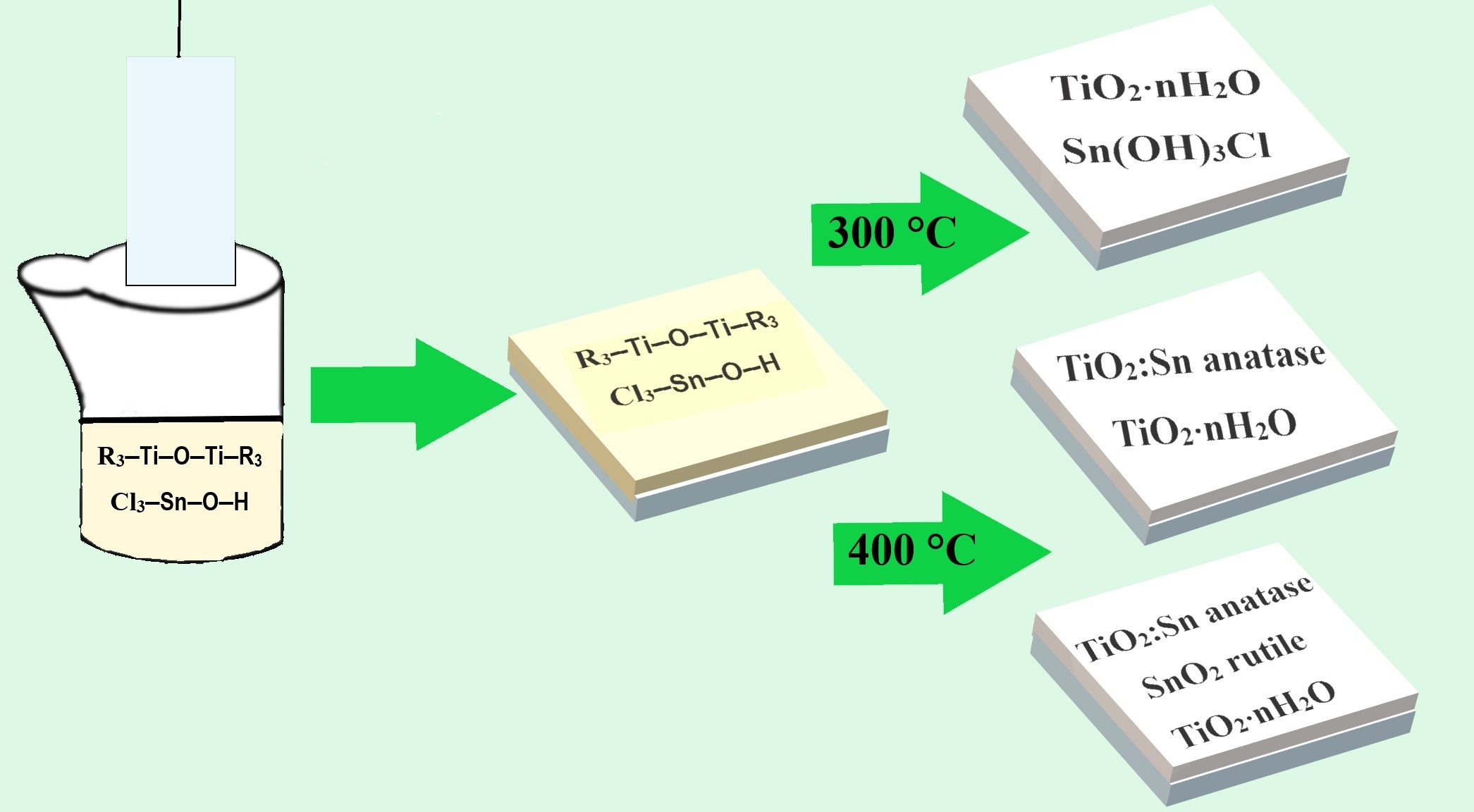Nanosystems: Phys. Chem. Math., 2022, 13 (2), 192–203
The joint effect of doping with tin(IV) and heat treatment on the transparency and conductivity of films based on titanium dioxide as photoelectrodes of sensitized solar cells
Svetlana Kuznetsova – National Research Tomsk State University, Tomsk, 634050 Russia
Olga Khalipova – National Research Tomsk State University, Tomsk, 634050 Russia
Yu-Wen Chen – National Central University, Jhongli, 32001, Taiwan; onm@mail.tsu.ru
Vladimir Kozik – National Research Tomsk State University, Tomsk, 634050 Russia
Corresponding author: Yu-Wen Chen, onm@mail.tsu.ru
DOI 10.17586/2220-8054-2022-13-2-192-203
ABSTRACT This study focuses on the preparation of transparent conducting TiO2 films with the addition of Sn(IV) by sol-gel method from film-forming solutions based on n-C4H9OH–(C4H9O)4Ti–SnCl4⋅5H2O at the temperature of 300–400 °C. Such films attract great attention because they can be used in flexible transparent photoanodes for the preparation of high effective sensitized solar cells. The morphology, phase composition, and optical properties of films were studied by X-ray diffraction, X-ray spectral microanalysis, scanning electron microscopy, spectrophotometry, and ellipsometry. The content of Sn(IV) influences the composition of films. The solid solution based on titanium dioxide with anatase structure is formed at a content of 5 mol.% Sn(IV); the films with a content of 10–30 mol.% Sn(IV) are the mixture of the TiO2: Sn solid solution and SnO2 with rutile structure. Regardless of the tin content, all films contain an amorphous TiO2⋅nH2O phase. The formation of oxide phases occurs through the stages of thermal destruction of Sn(OH)3Cl, tin acid, and burnout of butoxy groups of butoxytitanium(IV). The as-synthesized oxide films are uniform and continuity regardless of the tin content. An increase in the content of Sn(IV) in the composition of the films leads to an increase in their thickness from 48 to 105 nm and a decrease in the refractive index from 1.89 to 1.66. The minimum resistance value is characteristic for films that are the solid solution with an anatase structure and with an admixture of the amorphous phase of titanic acid. The surface resistance of the glass decreases by 108 times after deposition of the film based on TiO2 with 5 mol.% Sn(IV). Films based on TiO2 with 5 mol.% Sn(IV) are characterized by a higher transparency coefficient in the entire visible range of the spectrum (80–70%) and can be used in photoelectrode in dye-sensitized solar cells.
KEYWORDS film-forming solution, oxide composite film, tin oxide, titanium oxide, sol-gel method.
ACKNOWLEDGEMENTS This work was carried out within the framework of project No 18-29-11037 of Russian Foundation for Basic Research.
FOR CITATION S. Kuznetsova, O. Khalipova, Yu-Wen Chen, V. Kozik The joint effect of doping with tin(IV) and heat treatment on the transparency and conductivity of films based on titanium dioxide as photoelectrodes of sensitized solar cells. Nanosystems: Phys. Chem. Math., 2022, 13 (2), 192–203.
[In Russian] С. Кузнецова, О. Халипова, Ю-Вен Чен, В. Козик
Совместное влияние легирования оловом(IV) и термообработки на прозрачность и проводимость пленок на основе диоксида титана для фотоэлектродов сенсибилизированных солнечных элементов
АННОТАЦИЯ Настоящая работа посвящена получению прозрачных проводящих пленок TiO2 с добавкой Sn(IV) золь-гель методом из пленкообразующих растворов на основе n-C4H9OH–(C4H9O)4Ti–SnCl4⋅5H2O при температуре 300‒400 ºC. Такие пленки привлекают большое внимание, поскольку их можно использовать в гибких прозрачных фотоанодах для изготовления высокоэффективных сенсибилизированных солнечных элементов. Морфология, фазовый состав и оптические свойства пленок исследованы методами рентгенофазового анализа, микрорентгеноспектрального анализа, растровой электронной микроскопии, спектрофотометрии и эллипсометрии. Содержание Sn(IV) влияет на состав пленок. Твердый раствор на основе диоксида титана со структурой анатаза образуется при содержании 5 мол.% Sn(IV); пленки с содержанием 10-30 мол.% Sn(IV) представляют собой смесь твердого раствора TiO2:Sn и SnO2 со структурой рутила. Независимо от содержания олова все пленки содержат аморфную фазу TiO2⋅nH2O. Образование оксидных фаз происходит через стадии термической деструкции Sn(OH)3Cl, оловянной кислоты и выгорания бутоксигрупп бутоксититана(IV). Синтезированные оксидные пленки являются однородными и сплошными независимо от содержания олова. Увеличение содержания Sn(IV) в составе пленок приводит к увеличению их толщины с 48 до 105 нм и снижению показателя преломления с 1,89 до 1,66. Минимальное значение сопротивления характерно для пленок, представляющих собой твердый раствор со структурой анатаза и с примесью аморфной фазы титановой кислоты. Поверхностное сопротивление стекла снижается в 108 раз после нанесения пленки на основе TiO2 с 5 мол.% Sn(IV). Пленки на основе TiO2 с 5 мол.% Sn(IV) характеризуются более высоким коэффициентом прозрачности во всем видимом диапазоне спектра (80–70%) и могут быть использованы в фотоэлектродах в солнечных элементах сенсибилизированных красителями.
КЛЮЧЕВЫЕ СЛОВА пленкообразующий раствор, оксидные композитные пленки, диоксид олова, диоксид титана, золь-гель метод.
